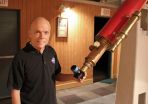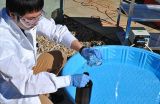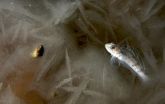(Press-News.org) SALT LAKE CITY, Sept. 23, 2014 – What's rocky, about a mile wide, orbits between Mars and Jupiter and poses no threat to Earth?
An asteroid named "Univofutah" after the University of Utah.
Discovered on Sept. 8, 2008, by longtime Utah astronomy educator Patrick Wiggins, the asteroid also known as 391795 (2008 RV77) this month was renamed Univofutah by the International Astronomical Union's Minor Planet Center in Cambridge, Massachusetts.
"It's neat," Wiggins says. "There aren't too many other universities on the whole planet with asteroids named after them. So that puts the U in rather rarified company."
"We are very honored," says Carleton Detar, the university's chairman of physics and astronomy. "Patrick Wiggins has been a dedicated champion of Utah amateur astronomy. Next, we'll need student volunteers to install a large block U on our asteroid."
Wiggins, who now works as a part-time public education assistant in the university's Department of Physics and Astronomy, had submitted the naming request in July as "Univ of Utah" but the naming agency changed it to Univofutah – much to the dismay of university marketing officials, who would have preferred "U of Utah." Wiggins says names must be limited to 16 characters, ruling out the university's full name.
The asteroid "is no more than 2 kilometers (1.2 miles) across," Wiggins says. Because of its small size and distance, it is "too far away for even the Hubble Space Telescope to determine the shape."
"Thankfully, this one will not be coming anywhere near the Earth," he adds. "It's a loooong way out. It is in the main asteroid belt. It stays between the orbits or Mars and Jupiter."
As a NASA solar system ambassador to Utah since 2002, Wiggins this year won NASA's Distinguished Public Service Medal, the space agency's highest civilian honor.
More than 655,500 Asteroids Now in the Main Belt
Thousands of asteroids are discovered each year, with the total now exceeding 655,500. More than 52,000 have been found so far this year and more than 5,000 so far this month, according to the Minor Planet Center. Near-Earth asteroids, which have orbits that can bring them near Earth, are much less common, with more than 40 discovered so far this year, 897 so far this month and 11,473 found in total.
Wiggins discovered Univofutah using a 35-centimeter (18.8-inch) optical telescope at his home observatory in Toole, Utah.
On the night it was discovered, asteroid Univofutah was about 137 million miles from Earth, almost 1.5 times the distance between the Earth and sun.
Univofutah is the fourth of five asteroids discovered by Wiggins. He also has spotted a number of previously known asteroids, and also thought he discovered a near-Earth asteroid – the kind that can threaten Earth – but it wasn't seen again. This year, he discovered his first supernova, or exploding star.
The other asteroids Wiggins discovered (the first one with his then wife) are Elko and Timerskine in 1999, Laurelanmaurer in 2007 and Nevaruth in 2008. Elko was named for his hometown in Nevada. Timerskine was named by his former wife for her second husband. Laurelanmaurer was named for a friend of a person who won the naming rights during a fundraising auction, and Nevaruth for the grandmother of Wiggins' former wife.
Asteroid Univofutah initially was numbered 391795 because it was the 391,795th minor planet – the term that astronomers use for asteroids – to be discovered and receive a number.
The rest of its original name – 2008 RV77 – is a code for the year and time of year it was discovered, with "R" meaning the first half of September and V meaning it was the 21st asteroid discovered during that half-month.
It took until earlier this year before the asteroid even qualified to be given a formal name. That is because "after the initial discovery, it has to be tracked long enough to where its orbit is well known and the International Astronomical Union is certain it's not a previously discovered minor planet," Wiggins says. "In the case of this one, that took until several months ago."
Wiggins worked from 1975 to 2002 for at Salt Lake City's Hansen Planetarium before it closed and Clark Planetarium was built. He also has been with the Salt Lake Astronomical Society since 1975, and has worked part time at the U since the 1990s. He teaches physics and astronomy in museums, schools and public events.
INFORMATION:
University of Utah Communications
75 Fort Douglas Boulevard, Salt Lake City, UT 84113
801-581-6773 fax: 801-585-3350
unews.utah.edu
Asteroid named for University of Utah makes public debut
Orbiting between Mars and Jupiter, 'Univofutah' is no threat to Earth
2014-09-23
ELSE PRESS RELEASES FROM THIS DATE:
Does size matter? MRI imaging sheds light on athletes most at risk for severe knee injury
2014-09-23
The successful rise and fall of an athlete's moving body relies on an orchestrated response of bones, joints, ligaments and tendons, putting the many angles and intersecting planes – literally the geometry – of a critical part like a knee joint to the test. But it's more than just a footfall error at the root of one of the most devastating of sports injuries: the ACL or anterior cruciate ligament tear. In fact, size – of the femoral notch that sits at the center of the knee joint – and volume of the ACL combine to influence the risk of suffering a noncontact ACL injury. ...
Infant cooing, babbling linked to hearing ability, MU researcher finds
2014-09-23
COLUMBIA, Mo. – Infants' vocalizations throughout the first year follow a set of predictable steps from crying and cooing to forming syllables and first words. However, previous research had not addressed how the amount of vocalizations may differ between hearing and deaf infants. Now, University of Missouri research shows that infant vocalizations are primarily motivated by infants' ability to hear their own babbling. Additionally, infants with profound hearing loss who received cochlear implants to help correct their hearing soon reached the vocalization levels of their ...
Solar energy-driven process could revolutionize oil sands tailings reclamation
2014-09-23
Edmonton—Cleaning up oil sands tailings has just gotten a lot greener thanks to a novel technique developed by University of Alberta civil engineering professors that uses solar energy to accelerate tailings pond reclamation efforts by industry.
Instead of using UV lamps as a light source to treat oil sands process affected water (OSPW) retained in tailings ponds, professors Mohamed Gamal El-Din and James Bolton have found that using the sunlight as a renewable energy source treats the wastewater just as efficiently but at a much lower cost.
"We know it works, so now ...
Antifreeze proteins in Antarctic fish prevent both freezing and melting
2014-09-23
Antarctic fish that manufacture their own "antifreeze" proteins to survive in the icy Southern Ocean also suffer an unfortunate side effect, researchers funded by the National Science Foundation (NSF) report: The protein-bound ice crystals that accumulate inside their bodies resist melting even when temperatures warm.
"We discovered what appears to be an undesirable consequence of the evolution of antifreeze proteins in Antarctic notothenioid fish," said University of Oregon doctoral student Paul Cziko, who led the research with University of Illinois animal biology ...
NYU-Mount Sinai Beth Israel study explores drug users' opinions on genetic testing
2014-09-23
Genomic medicine is rapidly developing, bringing with its advances promises of individualized genetic information to tailor and optimize prevention and treatment interventions. Genetic tests are already guiding treatments of the human immunodeficiency virus (HIV) and hepatitis c virus (HPC), and emerging research is showing genetic variants may be used to screen for an individual's susceptibility to addiction to a substance, and even inform treatments for addiction.
While there appear to be many benefits inherent in the development of this field and related research, ...
Slight alterations in microRNA sequences hold more information than previously thought
2014-09-23
(PHILADELPHIA) – Researchers have encountered variants or isoforms in microRNAs (miRNAs) before, but assumed that these variants were accidental byproducts. A recent study, published in the journal Oncotarget this month, shows that certain so called isomiRs have abundances that depend on geographic subpopulations and gender and that the most prevalent variant of a given miRNA may not be the one typically listed in the public databases.
"This study shows that microRNA isoforms are much more common than we had previously assumed. The fact that some isoforms are shared by ...
Mefloquine fails to replace SP for malaria prevention during pregnancy
2014-09-23
In this issue of PLOS Medicine, Clara Menendez from the Barcelona Institute for Global Health (ISGlobal), Spain, and colleagues report results from two large randomized controlled trials conducted in Africa to test an alternative drug for malaria prevention in HIV-negative and HIV-positive pregnant women.
Pregnant women and their unborn children are at a high risk for complications from malaria infection, and finding new treatment options is important because the malaria parasites are becoming increasingly resistant to the existing WHO-recommended drug sulphadoxine-pyrimethamine ...
Patients accept false-positives to achieve diagnostic sensitivity
2014-09-23
OAK BROOK, Ill. (September 23, 2014) – Both patients and healthcare professionals believe diagnosis of extracolonic malignancy with screening computed tomography (CT) colonography greatly outweighs the potential disadvantages of subsequent radiologic or invasive follow-up tests precipitated by false-positive diagnoses, according to a new study published in the October issue of the journal Radiology.
Diagnostic tests used for cancer screening programs usually target a specific organ. However, when screening for colorectal cancer with CT colonography, abdominal and pelvic ...
Medical students who attended community college likelier to serve poor communities
2014-09-23
IMPACT
The community college system represents a potential source of student diversity for medical schools and physicians who will serve poor communities; however, there are significant challenges to enhancing the pipeline from community colleges to four-year universities to medical schools. The authors recommend that medical school and four-year university recruitment, outreach and admissions practices be more inclusive of community college students.
FINDINGS
Researchers from UCLA, UC San Francisco and San Jose City College found that, among students who apply to and ...
Study helps assess impact of temperature on belowground soil decomposition
2014-09-23
Hilo, Hawai`i–The Earth's soils store four times more carbon than the atmosphere and small changes in soil carbon storage can have a big effect on atmospheric greenhouse gas concentrations. A new paper in the journal Nature Climate Change concludes that climate warming does not accelerate soil organic carbon decomposition or affect soil carbon storage, despite increases in ecosystem productivity.
The research, led by U.S. Forest Service Research Ecologist Dr. Christian Giardina, with the agency's Institute of Pacific Islands Forestry, Pacific Southwest Research Station, ...
LAST 30 PRESS RELEASES:
People with rare longevity mutation may also be protected from cardiovascular disease
Mobile device location data is already used by private companies, so why not for studying human-wildlife interactions, scientists ask
Test reveals mice think like babies
From disorder to order: flocking birds and “spinning” particles
Cardiovascular risk associated with social determinants of health at individual and area levels
Experimental NIH malaria monoclonal antibody protective in Malian children
Energy trades could help resolve Nile conflict
Homelessness a major issue for many patients in the emergency department
Undocumented Latinx patients got COVID-19 vaccine at same rate as US citizens
ETRI develops an automated benchmark for labguage-based task planners
Revolutionizing memory technology: multiferroic nanodots for low-power magnetic storage
Researchers propose groundbreaking framework for future network systems
New favorite—smart electric wheel drive tractor: realizes efficient drive with ingenious structure and intelligent control
Using stem cell-derived heart muscle cells to advance heart regenerative therapy
Damon Runyon Cancer Research Foundation awards Quantitative Biology Fellowships to four cutting-edge scientists
Climb stairs to live longer
Scientists capture X-rays from upward positive lightning
AMS Science Preview: Hawaiian climates; chronic pain; lightning-caused wildfires
Researchers advance detection of gravitational waves to study collisions of neutron stars and black holes
Automated machine learning robot unlocks new potential for genetics research
University of Toronto scientists appointed as GSK chairs will advance drug delivery research and vaccine education tools for healthcare professionals
Air pollution and depression linked with heart disease deaths in middle-aged adults
More efficient molecular motor widens potential applications
Robotic nerve ‘cuffs’ could help treat a range of neurological conditions
Researchers identify targets in the brain to modulate heart rate and treat depressive disorders
Findings of large-scale study on 572 Asian families supports gene-directed management of BRCA1 and BRCA2 gene carriers in Singapore
Many children with symptoms of brain injuries and concussions are missing out on vital checks, national US study finds
Genetic hope in fight against devastating wheat disease
Mutualism, from biology to organic chemistry?
POSTECH Professor Yong-Young Noh resolves two decades of oxide semiconductor challenges, which Is published in prestigious journal Nature
[Press-News.org] Asteroid named for University of Utah makes public debutOrbiting between Mars and Jupiter, 'Univofutah' is no threat to Earth



